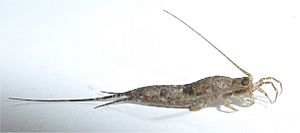Apterygota facts for kids
Quick facts for kids Apterygota |
|
|---|---|
 |
|
| Petrobius maritimus (Archaeognatha: Machilidae) |
|
| Scientific classification | |
| Kingdom: | |
| Phylum: | |
| Class: | |
| Subclass: |
Apterygota†
|
| Orders | |
|
|
The Apterygota are a small group of very old, simple insects. They are special because they have never had wings in their entire history. This is different from some other insects, like fleas, which lost their wings over time. Apterygotes are a primitive group, meaning they appeared before wings even developed in other insects.
Scientists have found their fossils in rocks from the Devonian period. This was about 400 million years ago! These ancient insects have some other simple features too.
Special Features of Apterygota
Apterygotes have several unique traits that show how old their group is:
- Simple Growth: Their young, called nymphs, look a lot like the adults. They don't go through big changes like a butterfly does. This is called little or no metamorphosis.
- Continuous Molting: Unlike most insects that stop growing when they become adults, Apterygotes keep molting (shedding their skin) throughout their lives. They can have many stages, called instars, even after they are old enough to have babies. Other insects usually only have one adult stage.
- Thin Skin: Their skin is often thin, which can make them look a bit see-through.
- Unique Reproduction: Male Apterygotes don't fertilize the female directly. Instead, they leave behind small packages of sperm for the female to pick up.
Currently, none of the Apterygota species are in danger of becoming extinct.
How Scientists Classify Apterygota
The way scientists group and name the Apterygota has changed over time. In the past, this group included four main types of insects: Collembola, Protura, Diplura, and Thysanura.
However, with newer ways of studying how living things are related (called Cladistics), scientists found that the Apterygota group wasn't quite right. They discovered that the first three groups (Collembola, Protura, and Diplura) are actually more closely related to each other. They now call this group the Entognatha.
Also, the Thysanura (which include silverfish) are more closely related to winged insects than to the other Apterygota. This means the original Apterygota group didn't include all the descendants of a common ancestor, making it a "paraphyletic" group. Scientists now try to make groups that include all descendants from a common ancestor.
Some scientists even think that Collembola (springtails) might not be insects at all, but their exact place in the animal kingdom is still being discussed.
See also
 In Spanish: Apterygota para niños
In Spanish: Apterygota para niños

